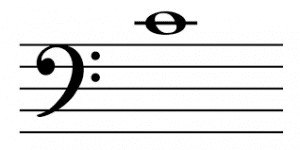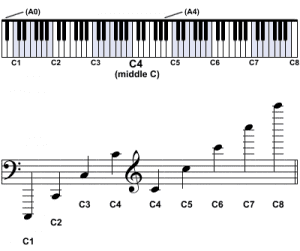There are 88 keys on acoustic and digital pianos as well as most professional keyboards. Piano keys may be labeled with a letter name and a numerical name. The number refers to the octave or regional position of the note (0-8), and the letter refers to the pitch (A-G). This labeling system is used by piano tuners and professional pianists alike.
The lowest note on the piano is A0, and the highest note is C8. There are eight full or complete octaves on the piano. A4 (400 Hz) is the standard tuning pitch for orchestras and other (western music) ensembles. This “A” is located in the fourth octave.
Let’s Take a Closer Look at the Bass Clef Notes on Piano
Let’s focus on the bottom half of the piano. This is the range notated in the bass clef. The bass clef is also called F-clef, and it resembles an ornate baroque “F.” The bass clef symbol contains a “bulb,” which sits on the F-line of the staff. The F-line also runs between the two dots of the clef. One dot sits above the F-line; the other is positioned below it.
To best understand bass clef notes on piano, start by identifying Middle C. This pitch is also called C4 since it is the fourth C on the piano as you move from left to right or bottom to top. We use middle C to orient ourselves on the instrument, and for beginners, it is often the top note written in the bass clef. Intermediate and advanced students may see bass clef notes extending up to G4 (but rarely higher).
G4 a perfect fifth above Middle C. Ledger lines are used when writing music above or below a staff. Ledger lines are like dashes, which extend the range of a staff in any direction (both higher and lower).
On the bottom end, the bass clef extends as low as A0. This is the lowest note on the piano. A0 note is rarely played. Maurice Ravel’s Jeux d’eau employs it, but you won’t see it notated very often.
A0 is located on the space below the sixth ledger line of the staff. Often, when very low bass notes are used, composers will write the pitch an octave higher, and use the musical symbol 8va or 8vb to tell the performer to play the note(s) one octave lower. When applicable, 8va and 8vb are written below the staff in bass clef.
So, What Will These Notes Look Like When You Read Them?
Now that you know the highest and lowest notes of the bass clef, let’s look at what you will be reading most of the time. All piano music is written on the grand staff (double staves). For beginners, the top staff is generally played by the right hand and features the treble clef. The bottom staff is generally played by the left hand and features the bass clef notes on piano. Both staves contain five lines and four spaces. From the bottom up, the bass clef lines are: G, B, D, F, A, and from the bottom up, the bass clef spaces are A, C, E, G. In the bass clef, Middle C is located on the first ledger line above the staff.
If you cannot remember the lines and spaces of the bass clef, you should use a mnemonic (memory device). There are many devices that people use, and you can even create your own.
Here are two mnemonics for the remembering the bass clef all notes:
Lines: Good Boys Deserve Fun Always
Spaces: All Cows Eat Grass
You will need to read the spaces and ledger lines below the staff too. For example, beginners may see the notes F2 or E2. F2 is located on the first space below the staff. E2 is a half step lower, and it is located on the first ledger line below the staff. Intermediate students may see the notes C2 and A2. These pitches are located on the second and third ledger lines, respectively. Between them (on the space) is the note B2. Advanced students may expect to see up to six ledger lines below the staff.
When reading any clef, you need to be able to read the alphabet, A through G, both forward and backward. As you ascend the keyboard, the letters move in the correct direction (A, B, C, D, E, F, G). However, many young students have difficulty reading backward from G to A (G, F, E, D, C, B, A). You must be able to read the letters backward as you descend the keyboard. This is a critical skill and it will impact your ability to navigate any clef. Remember, there are only seven letters (plus corresponding sharps and flats) in the musical universe.
The bass clef range of the piano has various uses. On the higher end of this range, chords may be created and (usually) played with the left hand. As you descend the keyboard, chords start to sound too muddy, especially when played as a block chord. When this happens, composers often arpeggiate chords to maintain clarity. In the bottom octave and a half, the sound becomes too thick and dense for any chord. In this range, roots and fifths are often employed instead of whole chords.
Bass Notes Are Used Across Instruments & Genres
Blues and jazz use single-note bass patterns such as “walking” bass lines and “eight to the bar” boogie-woogie shuffles. Many other funky bass patterns may be created too, and in this range, these bass clef notes inhabit the same zone as the electric bass, string bass, or tuba. Lastly, the bass clef register can be used for playing melodies. This can be a very effective tool for composers. It creates contrast, and often makes the music more “conversational.”
To hear an excellent example of how a composer might invoke mood and imagery in the bass clef, check out the haunting piece La Cathédrale Engloutie (The Sunken Cathedral) by the French composer Claude Debussy.
Eric Starr


